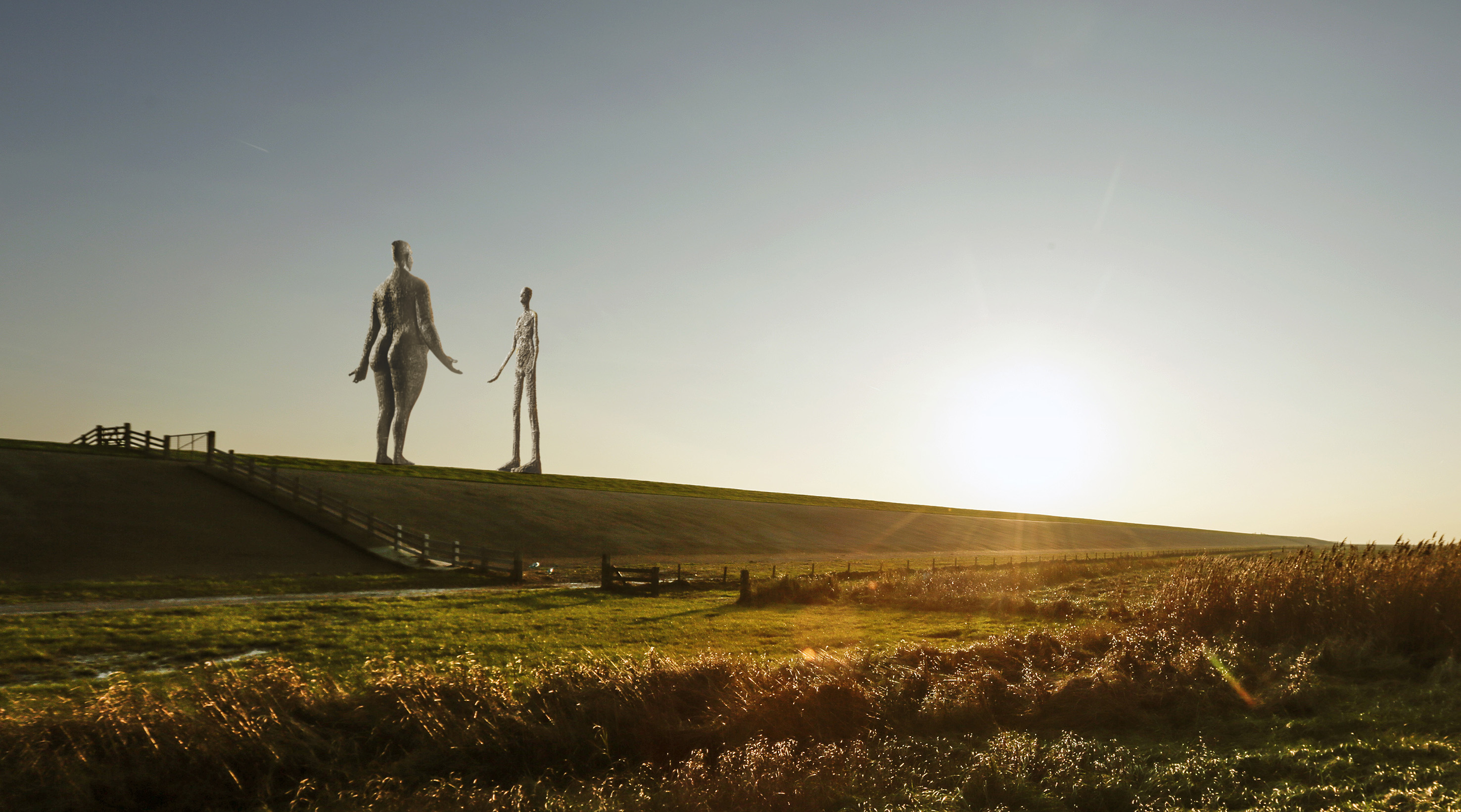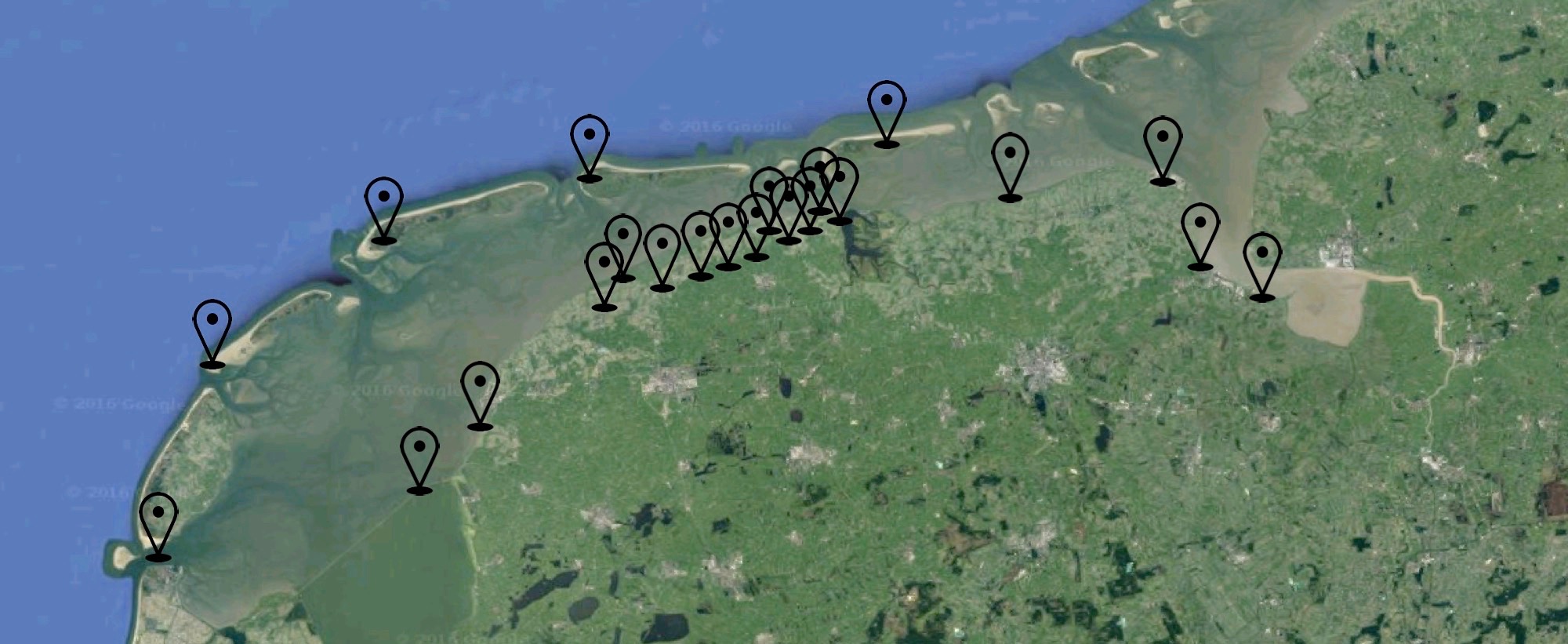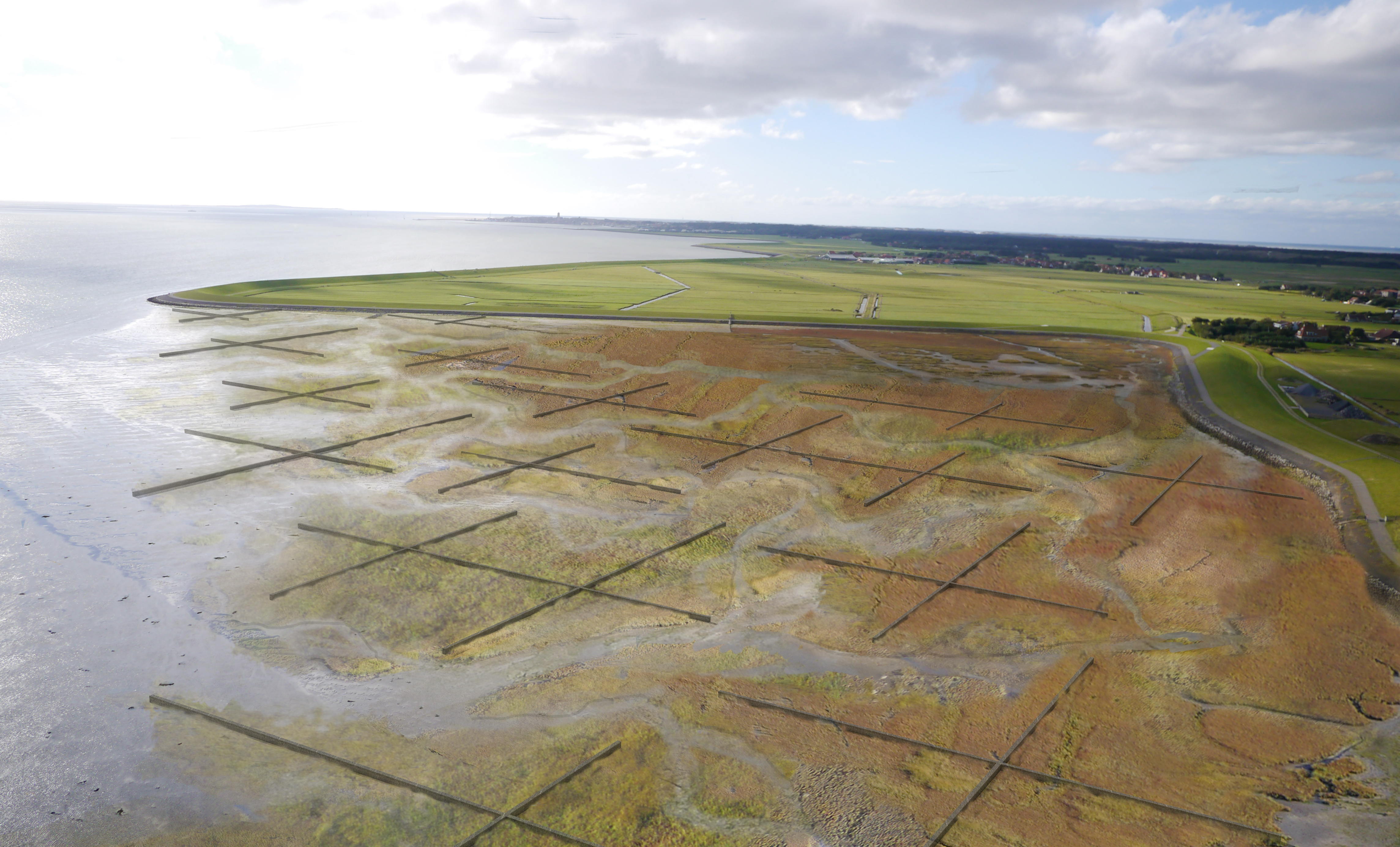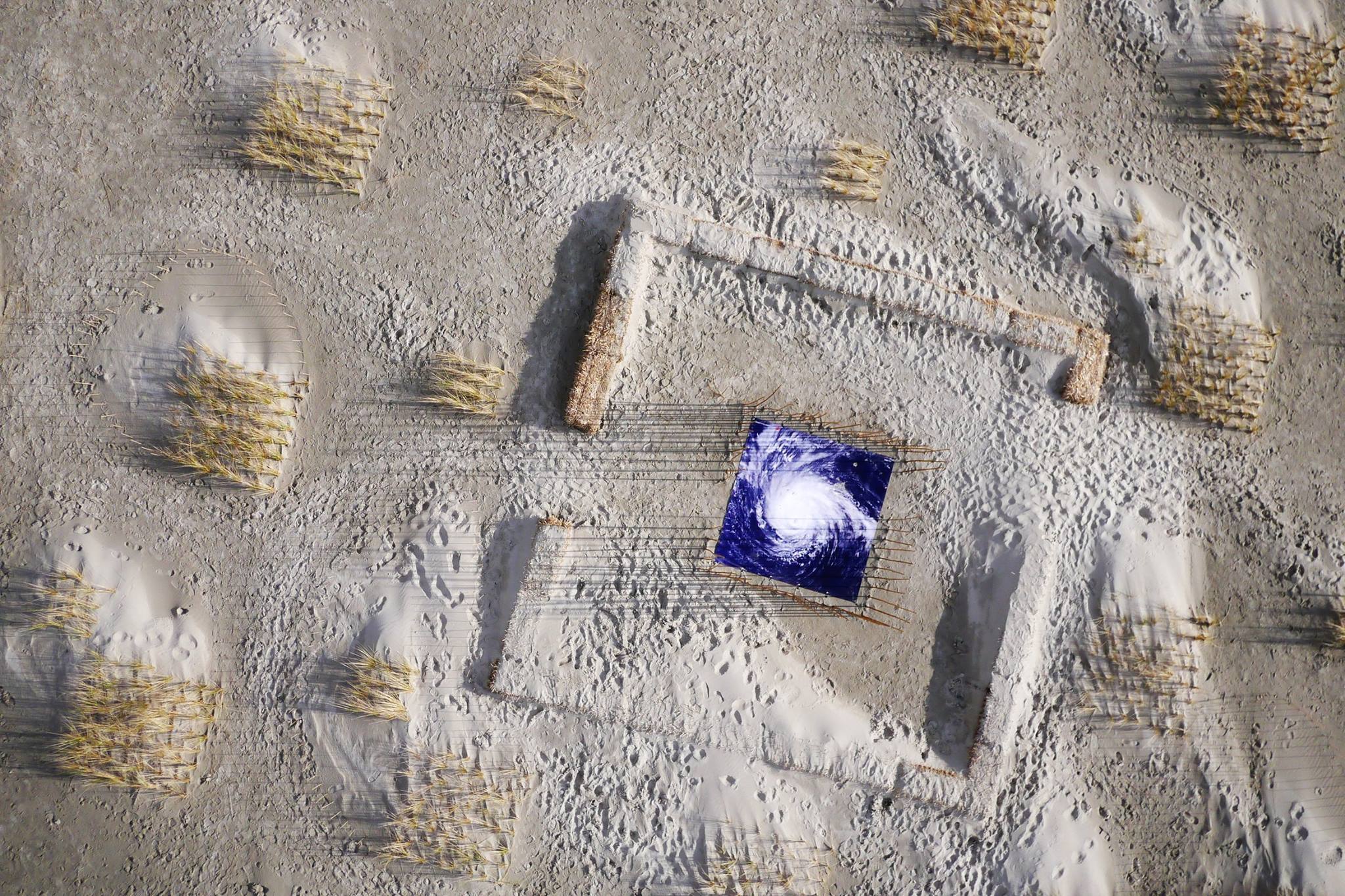About the statue
The statue consists of two metal welded 5 meter high women. One big woman, the other one slender, looking out over the sea. You can position yourself in-between these women, and take their hand. The statue represents the search for balance and exchange.
Jan Ketelaar is an artist from Friesland. In 2002 he graduated from the Minerva Academy,
cross-disciplinary sculpture. By the name of ‘Potzenmakerij Ketelaar’ he makes so called ‘potzen’: serious jokes.
He exhibited in e.g. Portugal, Bremen and New York.
Several times he travelled (by fork truck) through the Netherlands with his very tall statues.
In 2014 his Royal fence was placed around the 1st Royal lime-tree in the Netherlands. The fence was a bench, shaped of lime-tree leafs.
Apart from being a sculptor, he also writes and publishes poems.
In 2008 and 2012 he was in the final of the NK Poetry Slam.
Last year his first bundle was published: “Of a man who thought, I don’t want to think anymore”.
As a “potzenmaker’ he organizes literary and cultural meetings. He is also a planner.
In 2014 the policy regarding the search for lapwing eggs in Smallingerland changed on his initiative.
Expected realisation: September 2018

From the dizzying heights of the Camera Batavia watchtower – located on the Waddendijk dike near the Frisian village of Ternaard – you can observe the view from all directions through the unique perspective of a vortex mirror. It’s a disorienting and new experience that will offers a new, refreshing take on the landscape.
Test versions of the Camera Batavia tower were previously on display at the 2015 and 2016 editions of the annual Oeral festival on the island of Terschelling. The final version of the tower will be erected in Ternaard in 2018. You can experience the mirror image from the tower both on sofas in the exterior space and from the closed interior space (similar to a camera obscura).
Born in the Frisian town of Heerenveen in 1967, Arjen Boerstra currently lives in the village of Den Horn in Groningen province and works in the city of Groningen. He attended art school at Groningen’s Academie voor Beeldende Kunst Minerva, where he earned his degree in 1993. His work features a combination of installations, video, photographs and performance art.
Boerstra on his Camera Batavia project: ‘I decided to reconstruct the attic room from my childhood as a type of memory exercise and also to revisit some of the things that used to fascinate me as a child. I was an inquisitive and creative kid, and it was by rediscovering and observing the world around me that I got to recreate some of those early experiences.
The work should be regarded as an invitation to view the environment or a particular situation from a fresh and different perspective.’
Realisation: July 2018

Drie Streken (Three points of the Compass) is a wooden structure created by the visual artist Marc van Vliet that changes with the tides.
The artwork is ‘illuminated’ from three compass points through three large standing mirrors, placed kilometres away, which reflect the sun. Based on the sun and the tidal forces (and the moon), the artwork’s form change with the tide. This almost imperceptible variation occurs twice a day.
Visitors can reach the wooden artwork on foot: during ebb across the mudflat, and during tide across the 100-metre-long pedestrian bridge. It is a meeting place that offers a different perspective on the vastness of the Wadden landscape by the hour and the day. The visitor’s gaze is directed outwards during the ebb tide, and inwards during the flood.
A rough version of this artwork was displayed at the Oerol festival in 2015, and it has since been further refined and adapted so it can be set up in different parts of the Wadden Islands. As part of the European Capital of Culture celebrations in 2018, the Drie Streken artwork will be on display in the Wadden Sea at Hoek van de Bant.
About Marc van Vliet
Born in Den Bosch in 1961, this visual artist, theatre producer and designer is a resident of Overschild in Groningen province.
Self-taught in several disciplines and having started out as a designer, Van Vliet has risen to prominence over the past 17 years mainly through the location performances and installations of the Tuig theatre group with which we has been affiliated, which are characterised by a hybrid of images, motion and sound. In recent years, he has tended to focus on landscape installations.
Expected exhibition date: this project is under development

Expedition Waddenland connects extraordinary sites and projects with each other.
These projects and sites give a different perspective on the dynamic tidal land of the Wadden Sea and deepen the commitment of the inhabitants and visitors to this UNESCO World Heritage site.
An innovative combination of landscape development, natural and cultural heritage, human stories and encounters.
A unique journey of discovery, where you can experience the magic and mystique of the Wadden through the stories told about it. An important catalyst for cultural tourism as a significant economic factor.
We are consulting with renowned landscape architects and artists for the content and design of Expedition Sense of Place, such as Adriaan Geuze, Daan Roosegaarde, Robert Wilson and Peter Greenaway, as well as sustainable partners such as Groninger Landschap, It Fryske Gea, Staatsbosbeheer and Rijkswaterstaat.
The first stage of the trail extends from the head of North Holland to the Dutch-German border and has five clusters, that is, the Afsluitdijk, Harlingen, Holwerd, Lauwersoog and Eems/Dollard.
In the next stages, projects in the German and Danish Wadden will become part of the trail, which will unlock the Wadden as a UNESCO World Heritage site for inhabitants and visitors. The international Expedition Sense of Place will eventually run from Den Helder to Esbjerg.

Inspired by Piet Mondrian’s ‘Pier and Ocean’ painting, we are restoring and developing 30 hectares of new salt marshes on the southern end of Terschelling island in a pattern of dams and poles which are perpendicular to each other. In the unique and innovative nature of the open salt marsh structure, the slurry sinks and ‘pioneer’ plants will sprout up everywhere. This is a perfect example of how natural and cultural elements can be integrated.
In addition to being home to a rich ecosystem, this area also has salt marshes, which have a high conservation value and high gross and net primary productivity.
The salt marshes will not be accessible to the public, as this would disturb the natural environment and the birds in the area, but people can cycle across the road along these marshes.
A preliminary design called ‘Wadland’ was created by the landscape architect Bruno Doedens at the 2015 edition of the annual Oerol festival. It was a design with an open structure and strong visual appeal, inspired by Mondrian’s ‘Pier and Ocean’ painting, which represents a labyrinth of perpendicular fences made from the pleated feet of willows. A total of 250 students and volunteers spent five weekends working on the artwork – and this was only a miniature version measuring two hectares.
Created in conjunction with the Directorate-General of Public Works and Water Management, the Terschelling local council, the Province of Friesland, Wetterskip Fryslân and the Forestry Commission.
For more information: SLeM

‘Windwerk’ is an installation where human actions and forces of nature captivatingly meet each other. Inspired by the metamorphose-drawings by M.C. Escher the geometric landscape of marram grass fields slowly transforms into a dune landscape with natural shapes. With the wind being the most important driving source.
A project, in which research and innovational landscape provides new insides into dune formation and dynamic coastal management. For more information: slem.org
